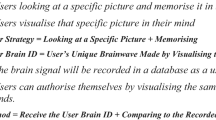Abstract
Brainwaves, as external signals of a functioning brain, provide a possible glimpse into how we think and react. However, seen another way, we could reasonably expect that a given action or event could be linked back to its corresponding brainwave reaction. Recently, commercial products in the form of commercial brainwave headsets have flooded into the market, opening up the possibility of exploiting brainwaves for various purposes and making this more feasible. In this paper, we build an authentication system based on brainwave reactions to a chain of events. We use a commercially available brainwave headset to collect brainwave data of participants for use in the proposed authentication system. After the brainwave data collection process, we apply a machine learning-based approach to extract features from brainwaves to serve as authentication tokens in the system and to support the authentication system itself.
The work was supported in part by the Academia Sinica, in part by the Taiwan Information Security Center, and in part by the Ministry of Science and Technology, Taiwan under Grants MOST 105-2221-E-259-014-MY3, MOST 105-2221-E-011-070-MY3, MOST 105-2923-E-182-001-MY3, and MOST 106-3114-E-011-003.
Access this chapter
Tax calculation will be finalised at checkout
Purchases are for personal use only
Similar content being viewed by others
References
Google SmartLock. https://get.google.com/smartlock/. Accessed 12 Apr 2018
How to take advantage of the Dynamic Lock feature in Windows 10. https://www.techrepublic.com/article/how-to-take-advantage-of-.the-dynamic-lock-feature-in-windows-10/. Accessed 12 Apr 2018
Eye Closed Brainwave Dataset. http://www.bri.com.tw/data/sample_data/BR8_sample%20data_eyeclosed20141205.rar. Accessed 12 Apr 2018
Zhou, L.: You think, therefore you are: transparent authentication system with brainwave-oriented bio-features for IoT networks. IEEE Trans. Emerg. Top. Comput. (Early Access)
Brain Partition. http://www.bri.com.tw/. Accessed 12 Apr 2018
Yeh, K.H.: I walk, therefore i am: continuous user authentication with plantar biometrics. IEEE Commun. Mag. 56, 150–157 (2018)
Matsuyama, Y.: Brain signal’s low-frequency fits the continuous authentication. Neurocomputing 164, 137–143 (2015)
Author information
Authors and Affiliations
Corresponding author
Editor information
Editors and Affiliations
Rights and permissions
Copyright information
© 2018 Springer Nature Switzerland AG
About this paper
Cite this paper
Chiu, W., Yeh, KH., Nakamura, A. (2018). Seeing Is Believing: Authenticating Users with What They See and Remember. In: Su, C., Kikuchi, H. (eds) Information Security Practice and Experience. ISPEC 2018. Lecture Notes in Computer Science(), vol 11125. Springer, Cham. https://doi.org/10.1007/978-3-319-99807-7_24
Download citation
DOI: https://doi.org/10.1007/978-3-319-99807-7_24
Published:
Publisher Name: Springer, Cham
Print ISBN: 978-3-319-99806-0
Online ISBN: 978-3-319-99807-7
eBook Packages: Computer ScienceComputer Science (R0)




